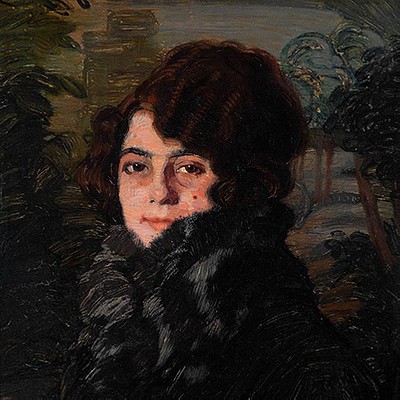JOAQUIN SUNYER DE MIRO (Sitges, Barcelona, 1874 - 1956) "Female portrait". Oil on canvas.
Lot 47
About Seller
Setdart Auction House
Carrer Aragó 346
Barcelona
Spain
Setdart Subastas was born in 2004 and is currently the first online art auction in Spain with solidity, prestige and reliability guaranteed by our more than 60,000 users. Setdart has a young, dynamic and enterprising team ready to successfully manage the purchase and sale of art works through custom...Read more
Estimate:
EUR€3,000 - EUR€4,000
$3,260.87 - $4,347.83
Absentee vs Live bid
Two ways to bid:
- Leave a max absentee bid and the platform will bid on your behalf up to your maximum bid during the live auction.
- Bid live during the auction and your bids will be submitted real-time to the auctioneer.
Bid Increments
| Price | Bid Increment |
|---|---|
| EUR€0 | EUR€10 |
| EUR€200 | EUR€25 |
| EUR€500 | EUR€50 |
| EUR€1,000 | EUR€100 |
| EUR€3,000 | EUR€200 |
| EUR€5,000 | EUR€500 |
| EUR€10,000 | EUR€1,000 |
| EUR€20,000 | EUR€2,000 |
| EUR€50,000 | EUR€5,000 |
About Auction
By Setdart Auction House
Jul 15, 2021
Set Reminder
2021-07-15 08:00:00
2021-07-15 08:00:00
America/New_York
Bidsquare
Bidsquare : 19th & 20th CENTURY PAINTINGS & ORIENTALISM
https://www.bidsquare.com/auctions/setdart-auction-house/19th-20th-century-paintings-orientalism-7212
Setdart Auction House sofia@setdart.com
Setdart Auction House sofia@setdart.com
- Lot Description
JOAQUIN SUNYER DE MIRO (Sitges, Barcelona, 1874 - 1956) "Female portrait". Oil on canvas. Signed in the central right area. Measurements: 50 x 43 cm; 86 x 74 cm (frame). Considered one of the maximum representatives of the noucentista style, Sunyer was nephew of the also painter Joaquim de Miró i Argenter, with whom he began in the painting. Within his work, his landscapes and female nudes stand out, as well as his portraits, totally distant from traditional painting. His compositions are an example of balance, always looking for the evocative power of images, figures and atmospheres. After studying at the Escuela de La Lonja in Barcelona, Sunyer began his career as an illustrator of popular scenes in "La Vanguardia" in 1896. That same year he took part in the Fine Arts Exhibition. Shortly after, he settled in Paris, where he specialized in street scenes and intimate interiors, which he treated in a style influenced by prostimpressionism. In Paris he befriended Picasso and Hugué, and exhibited in the Salons. During his Parisian period he worked with real dedication, evolving towards a post-impressionist language. Between 1905 and 1906 he traveled through Castile, on the initiative of the art dealer Henri Barbazanges, who wanted Spanish themes. He returned to Paris in 1907, and held several exhibitions in the French capital and Liège. He settles in Sitges in 1910, at a time when his style has been losing the post-impressionist influences and approaches the Mediterranean themes and the simplified canon figures of Cézanne. In these years a great change will occur in his painting, becoming a leading figure in the Noucentisme. His new language, based on an essential composition of clear structures and sober and transparent colors, clearly Mediterranean, would create a school within Catalan art. The following year, in 1911, Sunyer organizes a personal exhibition in the Faianç Catalá that placed him, after Nonell's death, at the head of the Catalan painting of the moment. During the following years he travels and exhibits in Europe, but returns to Catalonia at the outbreak of the First World War. Settled in Sitges, he nevertheless took part in the Paris and Barcelona Salons. After fleeing Spain because of the Civil War, he returned to Spain and settled in Barcelona in 1942. In 1949 he was awarded the Legion of Honor, and later special rooms were dedicated to him at the Hispano-American Art Biennials in Barcelona. At the Havana Biennial in 1954, he was awarded the Grand Prize for a lifetime of work. An anthological exhibition was also held in Madrid in 1974, commemorating the centenary of his birth. Joaquín Sunyer is currently represented at the MACBA, the Bilbao Fine Arts Museum, the Georges Pompidou Center in Paris and the Reina Sofía National Art Center in Madrid.
- Shipping Info
-
In-house shipping available. Please inquire at admin@setdart.com.
-
- Buyer's Premium



 EUR
EUR CAD
CAD AUD
AUD GBP
GBP MXN
MXN HKD
HKD CNY
CNY MYR
MYR SEK
SEK SGD
SGD CHF
CHF THB
THB














